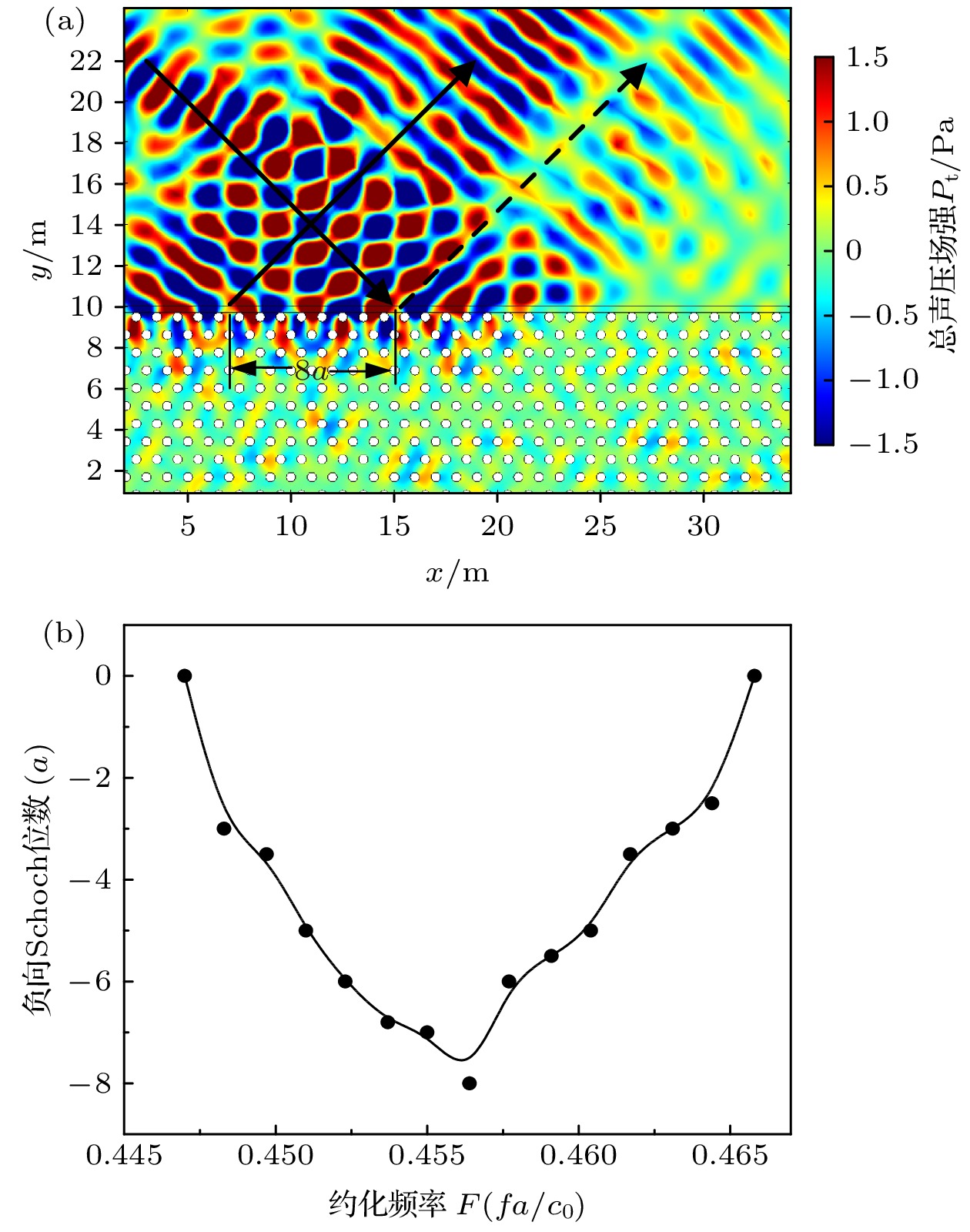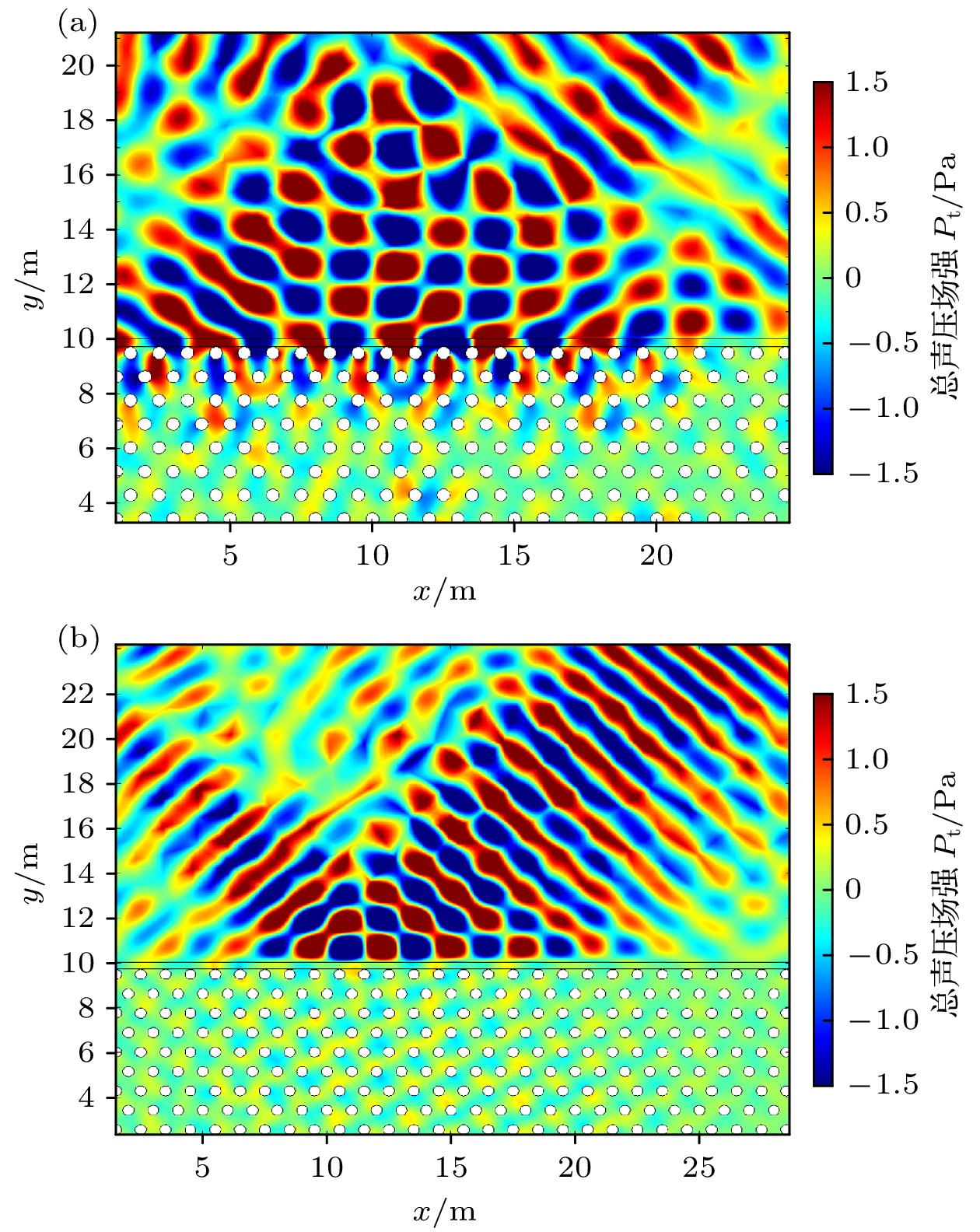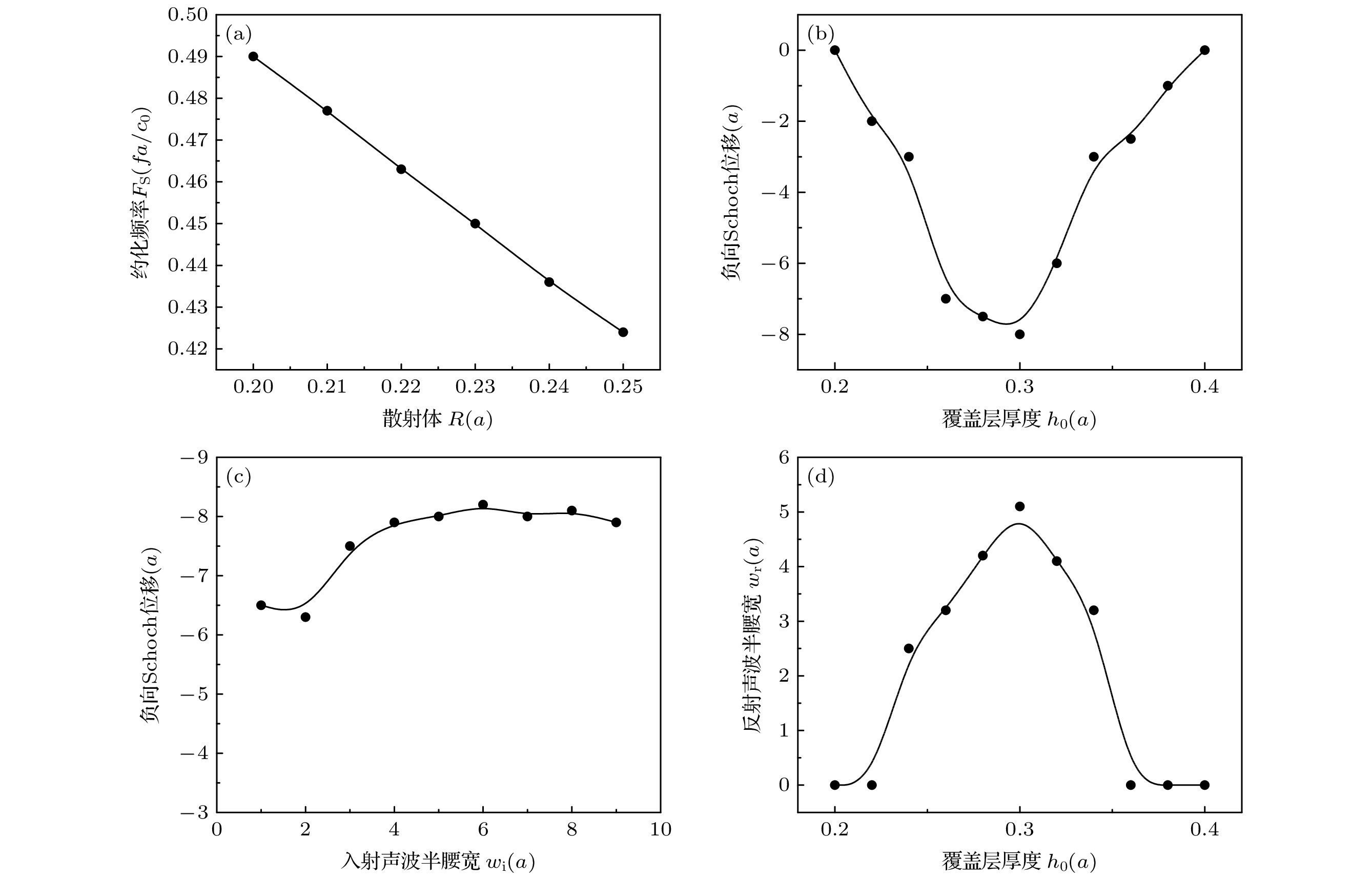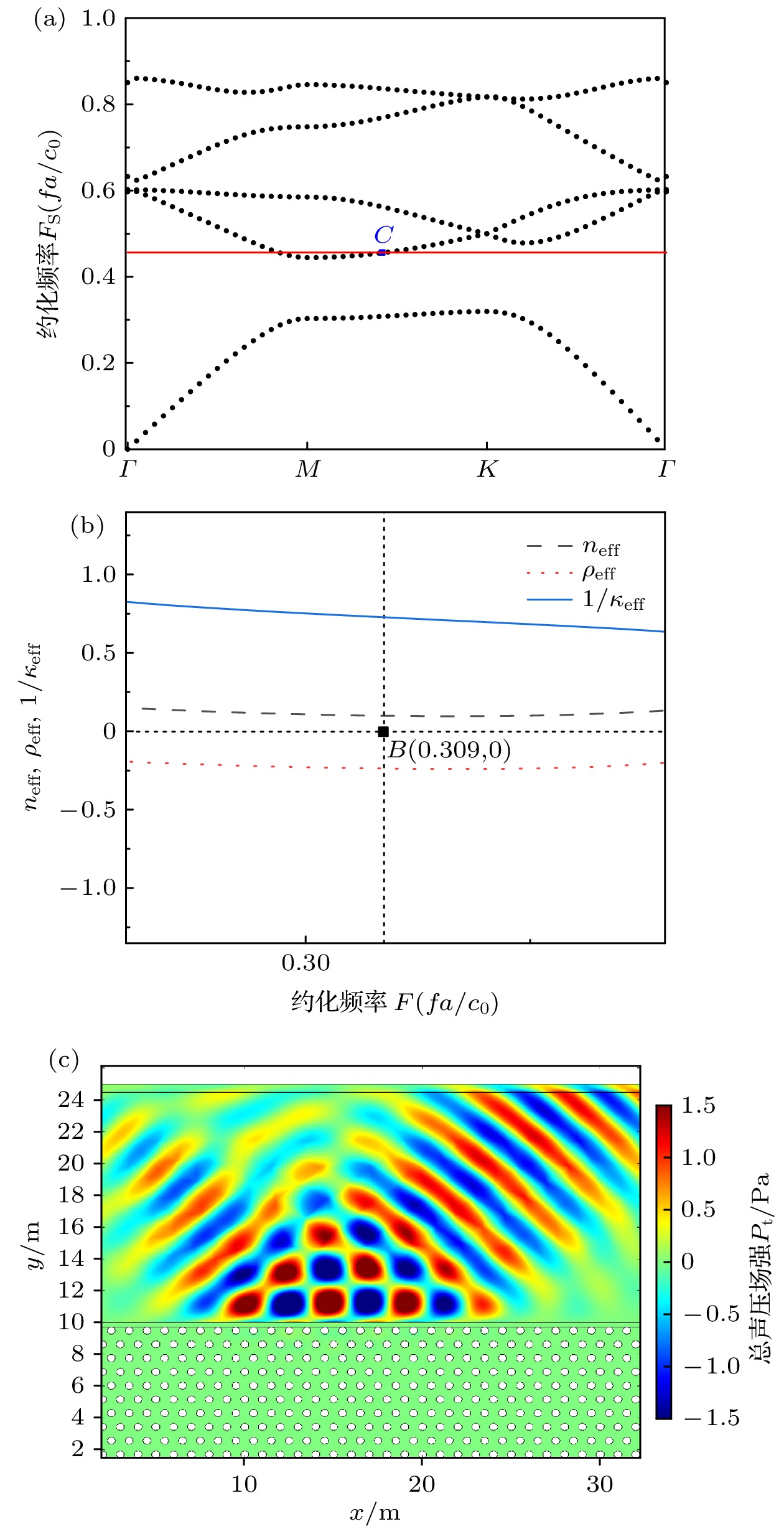-
对二维声学超材料与常规材料界面处的负向Schoch位移进行了研究. 研究表明, 在界面处增加合适厚度的覆盖层, 当声波在某一频率附近从常规材料向近零折射率材料传播时, 反射声波相对于入射声波会在界面处发生负向Schoch位移, 此时, 超材料的有效体积模量倒数值趋近于零从而使它成为一种折射率近零的声学材料; 同时, 超材料有效阻抗的极大值和反射系数的极大值都在这一特殊频率处且反射系数虚部相位在对应频率处有π rad的相位突变; 研究还发现, 发生负向Schoch位移的频率位于MK方向第一带隙中且靠近上边界的通带频率. 常规材料界面处的Schoch位移通常是正向的且大小可忽略不计的, 本文利用近零折射率声学材料实现了负向的Schoch位移, 为设计出基于界面声波的声学器件提供了一种新的理论参考.In this paper, the Schoch displacement at the interface between different two-dimensional triangular phononic crystal metamaterial and natural material is studied by using finite element software. As is well known, the Schoch displacement is highly dependent on the surface wave and leakage wave excited at the interface between different materials. So, the negative Schoch displacement can be more easily obtained by adding a suitable thickness of covering layer at the interface between metamaterial material and natural material. The numerical results show that when the negative Schoch displacement happens, the effective parameters of metamaterials are close to zero. It means that the effective refraction index is near to zero and the reduced frequency of the incident acoustic wave is correlated with the reduced frequency of the band gap. It is also found from the results that the reduced frequency of the incident acoustic wave is located at the edge of the band gap when the negative Schoch displacement occurs. The maximum of the metamaterial effective impedance and the maximum of the reflection coefficient are almost at the same frequency. The phase of the imaginary part of the reflection coefficient has a phase mutation in π rad at the corresponding frequency. The frequency of negative Schoch displacement is located in the first band gap of MK direction and near the upper boundary. The Schoch displacement at the interface between conventional materials is usually positive and negligible in previous reports. In this paper, the negative Schoch displacement is obtained by using the near-zero refraction index metamaterials. This not only enriches the physics contents of Schoch effect but also provides a theoretical reference for designing the acoustic devices based on acoustic wave displacement at the interface.
[1] Schoch A 1950 Schallreflexion, Schallbrechung und Schallbeugung (Berlin, Heidelberg: Springer) pp127−234
[2] Schoch A 1952 Acta Acust. United Acust. 2 372
 Google Scholar
Google Scholar
[3] Bertoni H L, Tamir T 1973 Appl. Phys. 2 157
 Google Scholar
Google Scholar
[4] Declercq N F, Degrieck J, Briers R, Leroy O 2003 Appl. Phys. Lett. 82 2533
 Google Scholar
Google Scholar
[5] Declercq N F, Degrieck J, Briers R, Leroy O 2004 J. Appl. Phys. 96 6869
 Google Scholar
Google Scholar
[6] Herbison S W, Declercq N F, Breazeale M A 2009 J. Acoust. Soc. Am. 126 2939
 Google Scholar
Google Scholar
[7] Declercq N F 2014 Ultrasonics 54 609
 Google Scholar
Google Scholar
[8] 陈宗旺, 姚源卫, 吴福根, 张欣, 董华锋, 陆水芳, 韩理想 2017 中国科学: 物理学 力学 天文学 47 064301
 Google Scholar
Google Scholar
Chen Z W, Yao Y W, Wu F G, Zhang X, Dong H F, Lu S F, Han L X 2017 Sci. China-Phys. Mech. Astron. 47 064301
 Google Scholar
Google Scholar
[9] Yang Z, Mei J, Yang M, Chan N H, Sheng P 2008 Phys. Rev. Lett. 101 204301
 Google Scholar
Google Scholar
[10] Mei J, Ma G C, Yang M, Yang Z Y, Wen W J, Sheng P 2012 Nat. Commun. 3 756
 Google Scholar
Google Scholar
[11] 沈惠杰, 温激鸿, 郁殿龙, 蔡力, 温熙森 2012 物理学报 61 134303
 Google Scholar
Google Scholar
Shen H J, Wen J H, Yu D L, Cai L, Wen X S 2012 Acta Phys. Sin. 61 134303
 Google Scholar
Google Scholar
[12] 陈凡, 郝军, 李红根, 曹庄琪 2011 物理学报 60 074223
 Google Scholar
Google Scholar
Chen F, Hao J, Li H G, Cao Z Q 2011 Acta Phys. Sin. 60 074223
 Google Scholar
Google Scholar
[13] Xu Y D, Chan C T, Chen H Y 2015 Sci. Rep. 5 8681
 Google Scholar
Google Scholar
[14] 陆志仁, 梁斌明, 丁俊伟, 陈家璧, 庄松林 2016 物理学报 65 154208
 Google Scholar
Google Scholar
Lu Z R, Liang B M, Ding J W, Chen J B, Zhuang S L 2016 Acta Phys. Sin. 65 154208
 Google Scholar
Google Scholar
[15] Fan Y C, Shen N H, Zhang F L, Wei Z Y, Li H Q, Zhao Q, Fu Q H, Zhang P, Koschny T, Soukoulis C M 2016 Adv. Opt. Mater. 4 1824
 Google Scholar
Google Scholar
[16] He J L, Yi J, He S L 2006 Opt. Express 14 3024
 Google Scholar
Google Scholar
[17] Shadrivov I V, Ziolkowski R W, Zharov A A, Kivshar Y S 2005 Opt. Express 13 481
 Google Scholar
Google Scholar
[18] Declercq N F, Lamkanfi E 2008 Appl. Phys. Lett. 93 054103
 Google Scholar
Google Scholar
[19] Lamkanfi E, Declercq N F, Van Paepegem W, Degrieck J 2009 J. Appl. Phys. 105 114902
 Google Scholar
Google Scholar
[20] Mei J, Liu Z Y, Wen W J, Sheng P 2006 Phys. Rev. Lett. 96 024301
 Google Scholar
Google Scholar
[21] Mei J, Liu Z Y, Wen W J, Sheng P 2007 Phys. Rev. B 76 134205
[22] Fokin V, Ambati M, Sun C, Zhang X 2007 Phys. Rev. B 76 144302
[23] Zhao D, Zhong D, Hu Y H, Ke S L, Liu W W 2019 Opt. Quantum Electron. 51 113
 Google Scholar
Google Scholar
[24] Huang X Q, Lai Y, Hang Z H, Zheng H H, Chan C. T. 2011 Nat. Mater. 10 582
 Google Scholar
Google Scholar
[25] Wan Y H, Zheng Z, Kong W J, Zhao X, Liu Y, Bian Y S, Liu J S 2012 Opt. Expres 20 8998
 Google Scholar
Google Scholar
[26] Enoch S, Tayeb G, Maystre D 1999 Opt. Commun. 161 171
 Google Scholar
Google Scholar
[27] Zhang J L, Jiang H T, Enoch S, Tayeb G, Gralak B, Lequime M 2008 Appl. Phys. Lett. 92 053104
 Google Scholar
Google Scholar
[28] Felbacq D, Smaali R 2004 Phys. Rev. Lett. 92 193902
 Google Scholar
Google Scholar
[29] Felbacq D, Moreau A, Smaali R 2003 Opt. Lett. 28 1633
 Google Scholar
Google Scholar
[30] Hou Z L, Fu X J, Liu Y Y 2004 Phys. Rev. B 70 014304
 Google Scholar
Google Scholar
[31] Tamir T, Bertoni H L 1971 J. Opt. Soc. Am. 61 1397
 Google Scholar
Google Scholar
[32] Berman P R 2002 Phys. Rev. E 66 067603
 Google Scholar
Google Scholar
-
图 2 (a) 具有明显负向Schoch位移的声压场图(
$R = $ $ 0.224 a$ , F = fa/c0 = 0.456 = FS, a = 1 m), 其中纵轴和横轴分别表示本文结构的高度y和宽度x, 右侧的颜色条对应的物理量为总声压场强Pt; (b) 在FS = 0.456附近, 负向Schoch位移随约化频率F的变化Fig. 2. (a) Acoustic pressure field with significant negative Schoch displacement (
$R = 0.224 a$ , F = fa/c0 = 0.456 = FS, a = 1 m); (b) relation of Schoch displacement to reduced frequency F near FS = 0.456.图 3 (a)
$F = 0.456$ , 水层和超材料界面附近出现大量后向漏波; (b)$F = 0.{{503}}$ , 水层和超材料界面附近完全没有漏波Fig. 3. (a)
$F = 0.456$ , there are a large number of backward leaky Rayleigh waves appear near the interface between the water layer and the metamaterial; (b)$F = $ $ 0.{{503}}$ , there is no leaky Rayleigh wave near the water layer and the metamaterial interface.图 4 声学超材料不同的物理参数特性 (
$R = 0.224 a$ , FS = 0.456) (a) 相对阻抗(Zeff)和反射系数(reff)随F的变化; (b) 有效折射率(neff)、有效质量密度(ρeff)、有效体积模量的倒数(1/κeff)随F的变化, 图像右下角内嵌图形为B点附近的放大Fig. 4. Different physical parameters of acoustic metamaterials (
$R = 0.224 a$ , FS = 0.456): (a) Relationship between relative impedance (Zeff) and reflection coefficient(reff) with F; (b) relationship of effective refractive index (neff)、effective mass density (ρeff) and inverse of effective volume modulus (1/κeff) to F, the embedded figure in the lower right corner of the image is an enlargement near point B.图 6 (a) 发生Schoch位移时FS随R的变化; (b) 负向Schoch位移随覆盖层厚度
${h_0}$ 的变化($R = 0.224 a$ , FS = 0.456); (c) 负向Schoch位移随入射声波半腰宽wi的变化; (d) 反射声波半腰宽wr随覆盖层厚度的变化Fig. 6. (a) Relationship of FS to R when the Schoch displacement happens; (b) relationship between negative Schoch displacement and overburden thickness
${h_0}$ ; (c) relationship between negative Schoch displacement and the half-waist width of the incident acoustic wave; (d) relationship between the half-width of the reflected acoustic wave and the thickness of the covering layer.图 7 (a) 超材料的带结构(
$R = 0.2{{24}}a$ ); (b) neff, ρeff, 1/κeff随F的变化; (c) 声波以带隙下边界频率($F{{ = 0}}{{.309}}$ )入射时超材料的声压场图Fig. 7. (a) Band structures of metamaterial (
$R = 0.2{{24}}a$ ); (b) relationship of neff, ρeff and 1/κeff to F; (c) acoustic pressure field diagram of metamaterial when acoustic waves incident at the lower band-gap boundary frequency. -
[1] Schoch A 1950 Schallreflexion, Schallbrechung und Schallbeugung (Berlin, Heidelberg: Springer) pp127−234
[2] Schoch A 1952 Acta Acust. United Acust. 2 372
 Google Scholar
Google Scholar
[3] Bertoni H L, Tamir T 1973 Appl. Phys. 2 157
 Google Scholar
Google Scholar
[4] Declercq N F, Degrieck J, Briers R, Leroy O 2003 Appl. Phys. Lett. 82 2533
 Google Scholar
Google Scholar
[5] Declercq N F, Degrieck J, Briers R, Leroy O 2004 J. Appl. Phys. 96 6869
 Google Scholar
Google Scholar
[6] Herbison S W, Declercq N F, Breazeale M A 2009 J. Acoust. Soc. Am. 126 2939
 Google Scholar
Google Scholar
[7] Declercq N F 2014 Ultrasonics 54 609
 Google Scholar
Google Scholar
[8] 陈宗旺, 姚源卫, 吴福根, 张欣, 董华锋, 陆水芳, 韩理想 2017 中国科学: 物理学 力学 天文学 47 064301
 Google Scholar
Google Scholar
Chen Z W, Yao Y W, Wu F G, Zhang X, Dong H F, Lu S F, Han L X 2017 Sci. China-Phys. Mech. Astron. 47 064301
 Google Scholar
Google Scholar
[9] Yang Z, Mei J, Yang M, Chan N H, Sheng P 2008 Phys. Rev. Lett. 101 204301
 Google Scholar
Google Scholar
[10] Mei J, Ma G C, Yang M, Yang Z Y, Wen W J, Sheng P 2012 Nat. Commun. 3 756
 Google Scholar
Google Scholar
[11] 沈惠杰, 温激鸿, 郁殿龙, 蔡力, 温熙森 2012 物理学报 61 134303
 Google Scholar
Google Scholar
Shen H J, Wen J H, Yu D L, Cai L, Wen X S 2012 Acta Phys. Sin. 61 134303
 Google Scholar
Google Scholar
[12] 陈凡, 郝军, 李红根, 曹庄琪 2011 物理学报 60 074223
 Google Scholar
Google Scholar
Chen F, Hao J, Li H G, Cao Z Q 2011 Acta Phys. Sin. 60 074223
 Google Scholar
Google Scholar
[13] Xu Y D, Chan C T, Chen H Y 2015 Sci. Rep. 5 8681
 Google Scholar
Google Scholar
[14] 陆志仁, 梁斌明, 丁俊伟, 陈家璧, 庄松林 2016 物理学报 65 154208
 Google Scholar
Google Scholar
Lu Z R, Liang B M, Ding J W, Chen J B, Zhuang S L 2016 Acta Phys. Sin. 65 154208
 Google Scholar
Google Scholar
[15] Fan Y C, Shen N H, Zhang F L, Wei Z Y, Li H Q, Zhao Q, Fu Q H, Zhang P, Koschny T, Soukoulis C M 2016 Adv. Opt. Mater. 4 1824
 Google Scholar
Google Scholar
[16] He J L, Yi J, He S L 2006 Opt. Express 14 3024
 Google Scholar
Google Scholar
[17] Shadrivov I V, Ziolkowski R W, Zharov A A, Kivshar Y S 2005 Opt. Express 13 481
 Google Scholar
Google Scholar
[18] Declercq N F, Lamkanfi E 2008 Appl. Phys. Lett. 93 054103
 Google Scholar
Google Scholar
[19] Lamkanfi E, Declercq N F, Van Paepegem W, Degrieck J 2009 J. Appl. Phys. 105 114902
 Google Scholar
Google Scholar
[20] Mei J, Liu Z Y, Wen W J, Sheng P 2006 Phys. Rev. Lett. 96 024301
 Google Scholar
Google Scholar
[21] Mei J, Liu Z Y, Wen W J, Sheng P 2007 Phys. Rev. B 76 134205
[22] Fokin V, Ambati M, Sun C, Zhang X 2007 Phys. Rev. B 76 144302
[23] Zhao D, Zhong D, Hu Y H, Ke S L, Liu W W 2019 Opt. Quantum Electron. 51 113
 Google Scholar
Google Scholar
[24] Huang X Q, Lai Y, Hang Z H, Zheng H H, Chan C. T. 2011 Nat. Mater. 10 582
 Google Scholar
Google Scholar
[25] Wan Y H, Zheng Z, Kong W J, Zhao X, Liu Y, Bian Y S, Liu J S 2012 Opt. Expres 20 8998
 Google Scholar
Google Scholar
[26] Enoch S, Tayeb G, Maystre D 1999 Opt. Commun. 161 171
 Google Scholar
Google Scholar
[27] Zhang J L, Jiang H T, Enoch S, Tayeb G, Gralak B, Lequime M 2008 Appl. Phys. Lett. 92 053104
 Google Scholar
Google Scholar
[28] Felbacq D, Smaali R 2004 Phys. Rev. Lett. 92 193902
 Google Scholar
Google Scholar
[29] Felbacq D, Moreau A, Smaali R 2003 Opt. Lett. 28 1633
 Google Scholar
Google Scholar
[30] Hou Z L, Fu X J, Liu Y Y 2004 Phys. Rev. B 70 014304
 Google Scholar
Google Scholar
[31] Tamir T, Bertoni H L 1971 J. Opt. Soc. Am. 61 1397
 Google Scholar
Google Scholar
[32] Berman P R 2002 Phys. Rev. E 66 067603
 Google Scholar
Google Scholar
计量
- 文章访问数: 5837
- PDF下载量: 117
- 被引次数: 0














 下载:
下载:



























